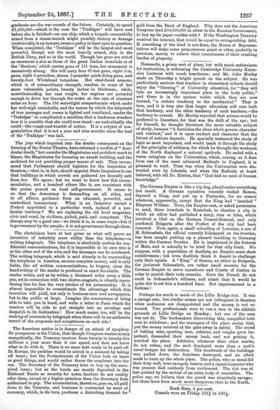A very special interest attaches to the launch of the
'Trafalgar,' from the fact that she and her sister-ship, the ' Nile,' are in all probability the last of the huge floating ironclad fortresses which will be built for the English Navy,—at least, such is the present opinion of the naval experts, who declare that the days of such ships are over, and that small, very swift cruisers and
gunboats are the war-vessels of the future. Certainly, to spend £1,000,000—which is the sum the ' Trafalgar' will have cost before she is finished—on one ship, which a torpedo successfully aimed from a steam-launch might possibly destroy or damage irretrievably in an instant, seems a policy at least open to question. When completed, the ' Trafalgar' will be the largest and most powerful, though not the most heavily armed, ship in the British Navy, and so in the world. Though her guns are not of as enormous a size as those of the great Italian ironclads or of the Benbow,' which carries guns of 111 tons, her armament is excessively strong. She will carry four 67-ton guns, eight 5-in. guns, eight 6-pounders, eleven 3-pounder quick-firing guns, and -twenty-four Whitehead torpedoes. Her steel-faced armour, which is of extraordinary strength, reaches, in some of her more vulnerable points, twenty inches in thickness ; while, notwithstanding her vast weight, her engines are powerful enough to drive her through the water at the rate of nineteen miles an hour. The 134 watertight compartments which make her well-nigh unsinkable, and the means by which the labyrinth of iron passages and rooms is lighted and ventilated, render the Trafalgar' so complicated a machine, that a landsman wonders how it is possible that she could ever stand—as undoubtedly she could—the rough-and-tumble of action. It is a subject of con- gratulation that it is not a year and nine months since the keel cif the Trafalgar' was laid.



































 Previous page
Previous page